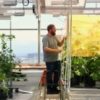
Case Studies
“When light passes through the quantum dots, the light spectrum is altered in a manner that is more beneficial to the plant.”
Owner, Growing Opportunities
Alcalde, New MexicoUbiGro® is a luminescent greenhouse film solution that optimizes sunlight within your greenhouse. This layer of light uses clean nanotechnology, known as quantum dots, to improve the quality of light in your greenhouse. UbiGro leverages unused parts of the sun’s spectrum, UV and blue photons, and converts them into orange, red, and far-red, giving your plants more of what they need to thrive.
Engineered for versatility, UbiGro seamlessly integrates with any greenhouse setup. Irrespective of type, size, or design, your plants can benefit from UbiGro’s advanced greenhouse covering materials. Choose UbiGro Cover for an external greenhouse cover application or UbiGro Inner for an internal retrofit addition. Growers utilizing either option experience healthier plants and gain up to a 30% boost in crop yields.
Talk to one of our greenhouse light experts today to learn more!
UbiGro’s greenhouse covering material is at the forefront of agricultural technology, using red-shifting quantum dots to optimize sunlight. Our films, UbiGro Cover and UbiGro Inner, offer long-term, sustainable solutions to enhance crop productivity.
Whether it’s an external greenhouse covering with UbiGro Cover or an internal retrofit with UbiGro Inner, our solutions are compatible with any greenhouse size or style. They’re easy to install, low-maintenance, and operate without electricity. Suitable for a diverse range of crops, from leafy greens to medicinal plants, UbiGro’s films provide a sustainable layer of light, maximizing the growth potential in any greenhouse environment.
Our dedicated team of crop lighting specialists will assist you in customizing a design and installation plan tailored to your greenhouse. UbiGro’s intuitive installation process eliminates the need for external support, empowering you with our step-by-step guide for seamless integration.
Download our UbiGro Inner installation guide to see how UbiGro fits into your greenhouse!
UbiGro's greenhouse cover material is easy to install. Suspended in a greenhouse, UbiGro attaches to your current structure and works with existing greenhouse structures.
Experience a tailor-made greenhouse covering material that meets your needs. From an even span to a ridge-and-furrow design, our horticulture experts will create a free custom plan for your greenhouse.
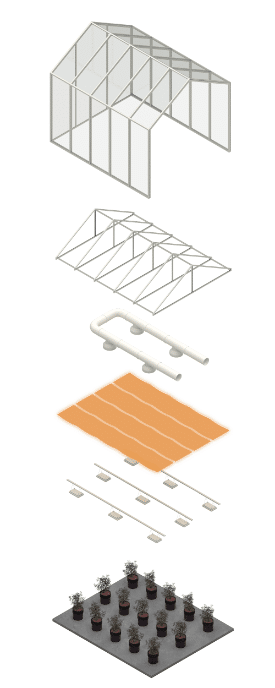
Enjoy an upgraded greenhouse covering, regardless of location, crop, or weather conditions. UbiGro works in any location worldwide and benefits a variety of crops including cannabis, tomatoes, ornamentals, and leafy greens.
UbiGro requires minimal ongoing operational expenses. This means a majority of our customers achieve payback in a year or less! UbiGro’s greenhouse cover material is a long-term solution for your greenhouse.
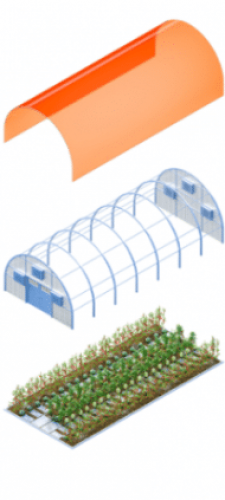
UbiGro Cover is designed to be a replacement to your current polyethylene greenhouse cover. Follow the same installation instructions from your greenhouse manufacturer. UbiGro Cover can be deployed as a single layer or part of a double-wall poly system.
UbiGro Cover can be used in any type of greenhouse that uses a poly cover. Whether used as a single layer for a hoop house or double-wall poly gutter-connect greenhouse, UbiGro Cover has your greenhouse covered!
There is no special maintenance needed for UbiGro Cover. Our quantum dot technology is built into the extruded poly covering and you can handle and care for UbiGro Cover just as you do any other poly greenhouse covering.
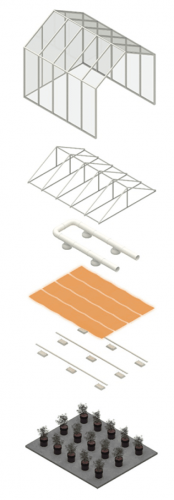
UbiGro has been deployed worldwide in over 76 trials at more than 31 unique greenhouse sites. Within these trials, cultivators are achieving an outstanding ROI and increasing their production with every square foot UbiGro is deployed.
UbiGro will boost your production without adding energy or electrical costs. When you leverage UbiGro’s clean quantum dot technology, you harness the power of your greatest natural resource: the sun.
UbiGro’s greenhouse coverings provide the necessary light for your crops to thrive without increasing your energy bill.
UbiGro’s flexible solutions work with existing greenhouse systems and will not hinder their current function. Learn more about the benefits of UbiGro and talk to one of our greenhouse light experts today.

Owner, Growing Opportunities
Alcalde, New Mexico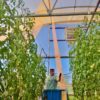
Owner, Waihee Valley
Maui, HI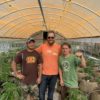
Owner, Little Hill Cultivators
Trinity County, CA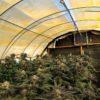
Owner & Head Grower, Frontier Farms
Hood River, OR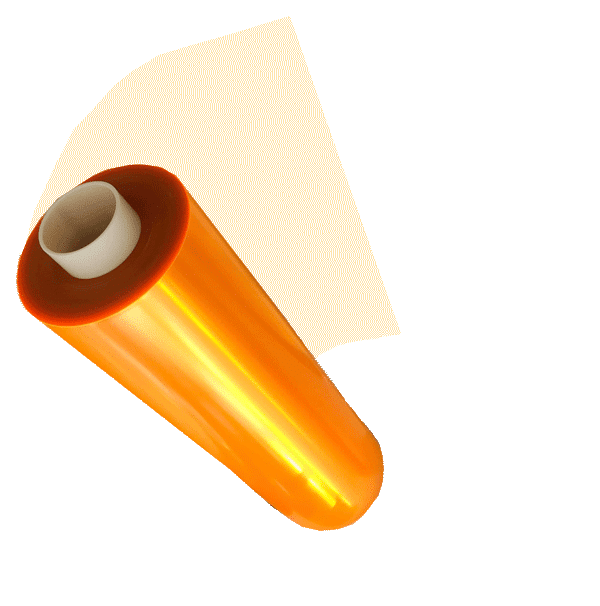
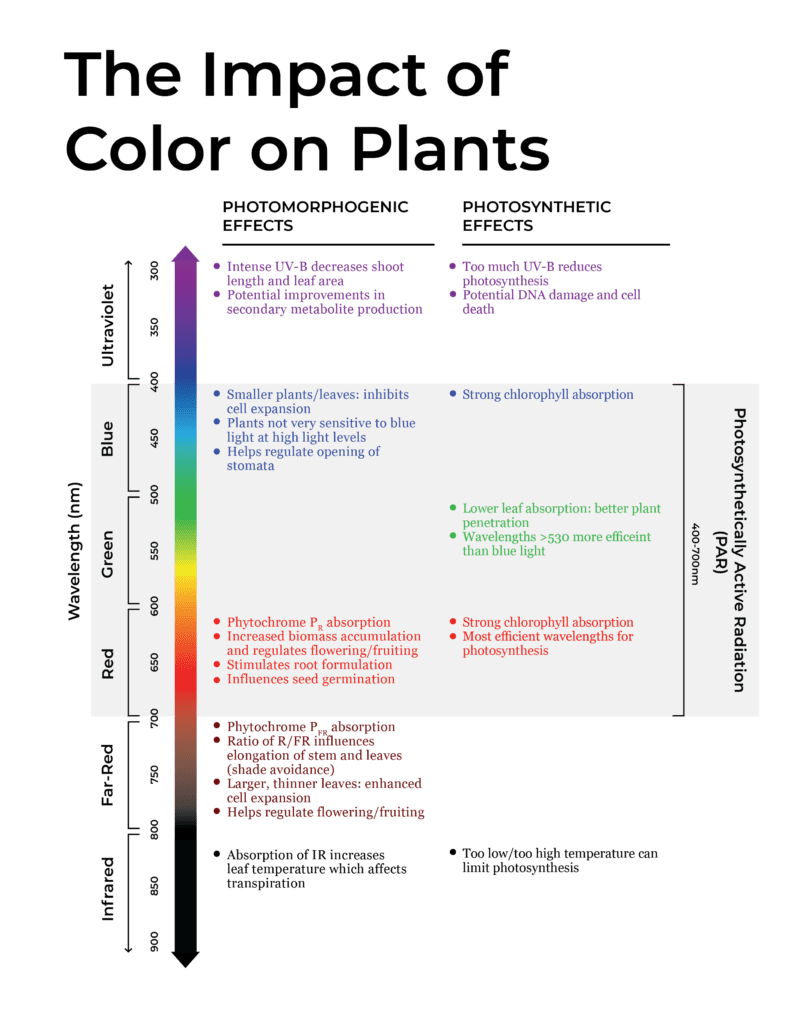

Hunter McDaniel, PhD
Founder & CEO
Hunter earned a Ph.D. in Materials Science and Engineering at the University of Illinois at Urbana-Champaign, before joining Los Alamos National Laboratory in the Chemistry Division. Ultimately the value proposition of UbiGro is about boosting crop yields and quality without the cost or energy impact of lighting. Hunter has more than fifty publications and patents, and more than 2000 total citations, h-index: 20. Hunter fundamentally believes that novel materials underpin every significant technology advancement, and he is focused on leveraging new materials to have a lasting and sustainable impact.

Damon Hebert, PhD
Director of Agriculture
Damon brings a wide range of experience in agriculture, materials science, spectroscopy, and small business. During his time in Prof. Angus Rockett’s research group at The University of Illinois at Urbana-Champaign (UIUC), Hebert authored a doctoral thesis and multiple papers on the materials science of CIGS semiconductor materials, which is closely related to the materials developed at UbiQD. He also served as a consultant to Nanosolar, a CIGS nanocrystal solar cell manufacturing company. Hebert has industry experience having co-founded Dr. Jolly’s, a leading cultivation and distribution operation in Bend, OR.

Tania Lafaille
Sales Representative
Tania is a UbiGro Sales Representative, with over 7 years of experience in product sales (specifically berries and avocados) covering all of North America and parts of South America. While in agriculture, Tania has cultivated strong relationships with growers and distributors, granting her a unique insight into both perspectives. That understanding, paired with her fierce dedication to results, drives her fun and fiery commitment to her craft. Tania is based in Gilroy, CA.

Tyler Veyna
Sales Representative
Tyler brings 15 years of experience in Greenhouse production and facility management of a wide range of crops in multiple states to the UbiGro team. Based in Salinas, California. “Being a fourth-generation farmer, I look to improve and empower the grower, and with UbiGro, we can do just that.”

Jim Gideon
Sales Manager
Jim Gideon is an UbiGro Sales Manager, with over 25 years of greenhouse industry sales experience covering all of North America. Previously Jim has worked for Green Tek, Plazit-Polygal, Texel, Cherry Creek, and Nexus. He is based in Montgomery, AL, and Jim believes that “light is everything to the grower.”

Eric Moody
Director of Sales
Eric Moody is UbiQD’s Director of UbiGro Sales. Eric has more than 6 years of experience in horticulture lighting industry, building relationships with greenhouse growers of all sizes and crops on optimal lighting for their growing operation, and most recently managed a North American sales team for PL Light Systems. Overall, Eric has been in sales leadership positions for more than 13 years. Eric brings with him a great understanding of the market and available technologies for growers, greenhouse facilities, and sales leadership. Reach Eric by phone at 541-490-6421 or by email at [email protected].

Mike Burrows, PhD
Dr. Michael Burrows is UbiQd’s Vice President of Business Development. His educational background includes a Materials Science doctorate from the University of Delaware and an MBA from Duke University Fuqua School of Business. His career has specialized in the commercialization of novel electronic materials in venture-run programs for different industries including solar, biosensors, and the automotive industry. In both start-up and corporate environments, he has extensive experience in global market development, foraging supply chain partnerships, productization, and brand building. He is currently leading UbiQD’s partnership efforts in luminescent greenhouse technology, smart windows, and security ventures.

Matt Bergern, PhD
Cheif Product Officer
As Chief Product Officer at UbiQD, Dr. Matt Bergren leads the company’s product development efforts, sales, and product manufacturing, including the company’s first commercial agriculture product, UbiGro. He plays a critical role in continuing the company’s path of technology development and vision of powering product innovations in agriculture, clean energy, and security.
He serves as the principal investigator for UbiQD’s contract with NASA, focused on tailoring the solar spectrum for enhanced crop production for space missions. Dr. Bergren’s leadership experience includes serving on the board of directors for the New Mexico Energy Manufacturing Institute, focused on job creation in New Mexico’s energy, and related manufacturing community.